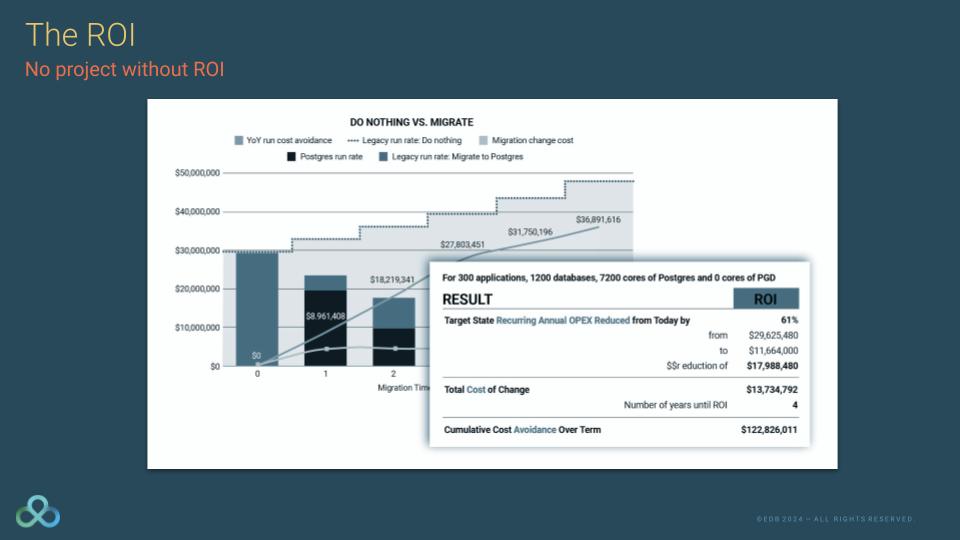In the second webinar of our Navigating Your Database Migration Journey series, EDB Field CTO Julian Moffett and EDB Technical Fellow Marc Linster discuss how migration is much more than a technical process. It’s actually a transformative and collaborative journey that begins long before data is transferred.
Here are some of the key points from the discussion:
Migration isn’t just a technical challenge
Julian Moffett emphasized that people don't run databases for fun, but rather because they’re part of their application ecosystem and core business assets. While migration often originates when the infrastructure team realizes there’s an opportunity to reduce costs and introduce a newer, more innovative database platform, the technical work shouldn’t begin until your goals, scope, ROI and timeline are clearly defined. The technical aspect encompassing database assessment, schema remediation and data migration represents the final stage, and is actually only a small portion of the overall process!
So migration isn’t simply a matter of replacing outdated databases with newer ones, but an all-inclusive change management project.
Define and engage stakeholders
Stakeholder management is a critical component of the migration process. Getting support from your application teams is essential, because as discussed in the first webinar in our series, no matter the size of your migration, you’ll need to validate that migrated applications work as expected. That’s why you’ll need to engage your app teams from the beginning and ensure they’re ready to test the database and refactor code if needed – otherwise, your original database may not get decommissioned.
Finance is another significant stakeholder, as they’ll want to understand the value of migration and how much it will cost to achieve it. Other stakeholders can include security and compliance teams and business heads. Sometimes going straight to the top and getting buy-in from the CTO or CIO can help to drive migration efforts holistically across your enterprise. The right support makes all the difference.
Define SMART goals
SMART methodology – Specific, Measurable, Achievable, Relevant, and Time-bound – can be a valuable tool for managing stakeholder objectives. By setting clear, realistic and measurable migration goals that align with your company and stakeholder objectives, you can avoid potential pitfalls.
EDB’s process and tools help companies meet their goals by dramatically reducing the amount of effort needed to recode or refactor their PL/Sequel or applications. It’s important to be able to reduce the actual volume of work and also articulate estimated costs.
Communicate the benefits
Sometimes people are hesitant to support migrating because they have other projects and business deliverables that they're under pressure to meet. Fear of the unknown and perceived migration costs can also be factors. That’s why you’ll need to identify how migrating will benefit your enterprise, application teams and everyone involved.
Reasons to migrate to Postgres
EDB offers a free ROI calculator that you can use to estimate how much you’ll save by migrating from Oracle to Postgres. Beyond increasing ROI and decreasing costs, many teams migrate to Postgres for the improved developer experience and increased agility. Being able to deliver a very high degree of automation and deploy databases without manual intervention are also important to infrastructure providers.

Another reason to migrate is the ability to attract and retain talent. Modern technologies like Postgres are enticing to recent graduates, who are more likely to have learned databases on these platforms. Introducing these technologies can help retain existing staff and attract new talent, preserving institutional knowledge and promoting growth.
In addition, the new analytical and AI capabilities of EDB Postgres are also compelling for developers. The meteoric rise of generative AI has dramatically changed our industry landscape. Developers and database administrators are very interested in vector databases right now, and Postgres can happily run as a vector database.
Migration is a marathon, not a sprint
Being successful requires going beyond the technical aspects of migration to define the stakeholders, the process and the benefits.
“You cannot over communicate this,” says Julian. “You've got to really articulate clearly to the stakeholders what the value is, why this is of importance to your company and what key upsides are for your stakeholders.”
When asked what advice Julian would offer based on all his migration experience, Julian concluded, “Do your prep, get the team mobilized, communicate, get metrics in place and monitor as you go. And be prepared to be tenacious and to chip away for a while. That's what ultimately unlocks the real benefits.”
Watch the full webinar episode #2 here
Have questions on migrating to Postgres or need support? Contact us!
Interested in Decoding Oracle Migration: Insights Into Scope and ROI? Read the blog here.
